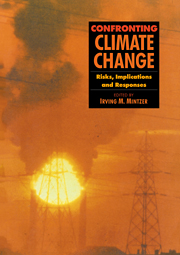Book contents
- Frontmatter
- Contents
- Foreword
- Acknowledgements
- List of Reviewers
- 1 Living in a Warming World
- I The Science of Climate Change
- II Impacts of Global Climate Change
- III Energy Use and Technology
- IV Economics and the Role of Institutions
- V Equity Considerations and Future Negotiations
- 21 Sharing the Burden
- 22 Climate Negotiations: the North/South Perspective
- 23 Shaping Institutions to Build New Partnerships: Lessons from the Past and a Vision for the Future
- Annex I
- Annex II
- Glossary
- Index
23 - Shaping Institutions to Build New Partnerships: Lessons from the Past and a Vision for the Future
Published online by Cambridge University Press: 06 January 2010
- Frontmatter
- Contents
- Foreword
- Acknowledgements
- List of Reviewers
- 1 Living in a Warming World
- I The Science of Climate Change
- II Impacts of Global Climate Change
- III Energy Use and Technology
- IV Economics and the Role of Institutions
- V Equity Considerations and Future Negotiations
- 21 Sharing the Burden
- 22 Climate Negotiations: the North/South Perspective
- 23 Shaping Institutions to Build New Partnerships: Lessons from the Past and a Vision for the Future
- Annex I
- Annex II
- Glossary
- Index
Summary
Editor's Introduction
Pollutant emissions from human activities are changing the composition and behaviour of the atmosphere. In the process, they threaten to disrupt the Earth systems upon which all life depends. To minimize these risks and to limit the damages from changes which are now unavoidable, it will be necessary to re—tool existing institutions to meet the new and emerging challenges.
William Nitze, Alan S. Miller and Peter H. Sand begin with an assessment of the major trends that have contributed to the current conditions. They observe that the traditional development path followed historically by the advanced industrial countries has produced the great bulk of atmospheric pollutant emissions. However, the continuing trend toward dematerialization of these economies — a process that leads to continuous reductions in the quantity of material required to produce a unit of output—has also been spreading steadily in recent years. This trend in engineering design is reinforced by the management theories of statistical quality control and the principles of continuous improvement. It is strengthened further by the use of market-oriented policy mechanisms and the movement toward full social cost pricing.
At the same time, the ability of the world community to tackle environmental problems has also evolved. Nitze, Miller and Sand regard the processes leading to the Montreal Protocol on Substances that Deplete the Ozone Layer and the London Guidelines on Toxic Substances as demonstrations that cooperative action between scientists, governments, and non-governmental organizations can be practical and fruitful.
- Type
- Chapter
- Information
- Confronting Climate ChangeRisks, Implications and Responses, pp. 337 - 350Publisher: Cambridge University PressPrint publication year: 1992

